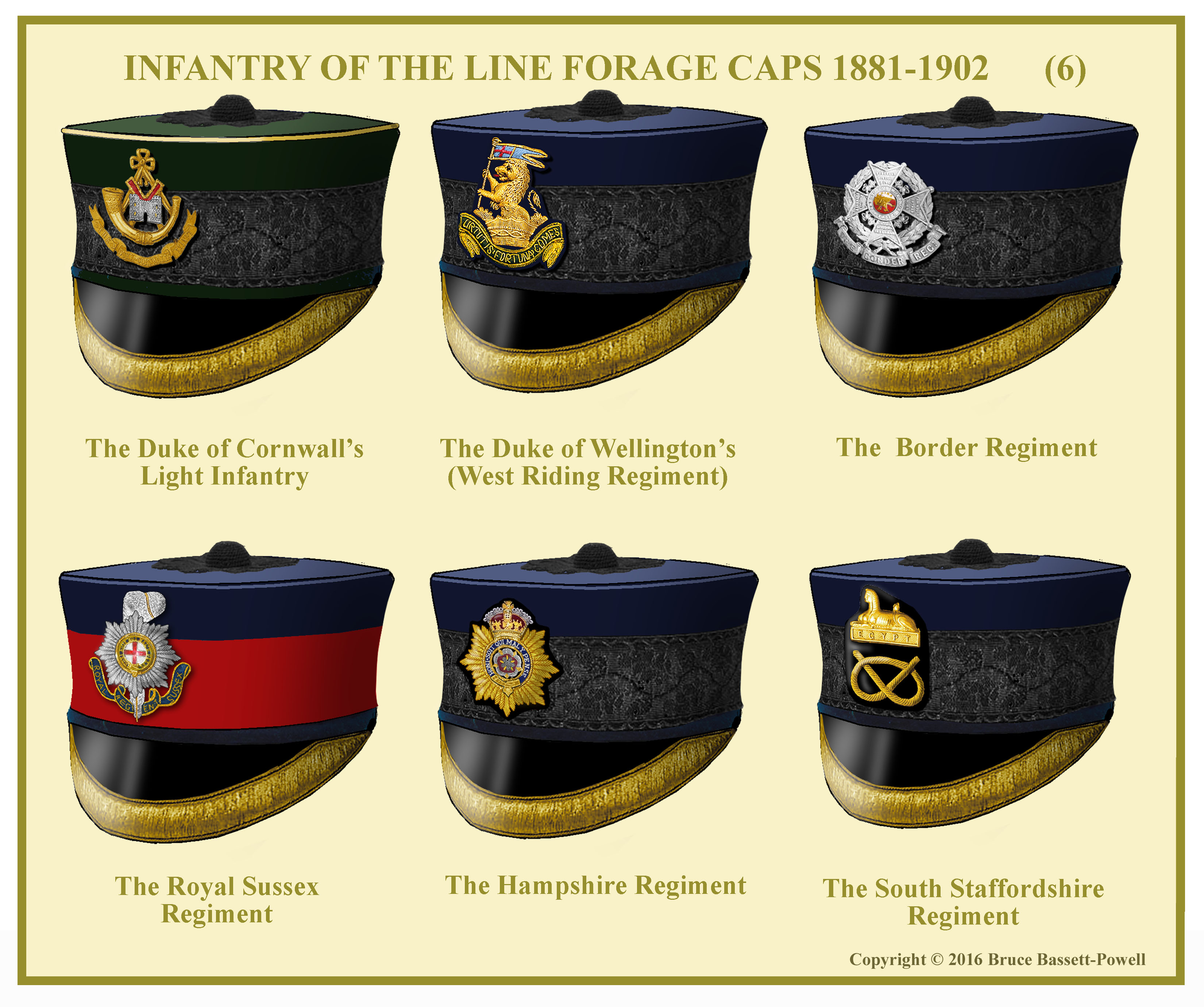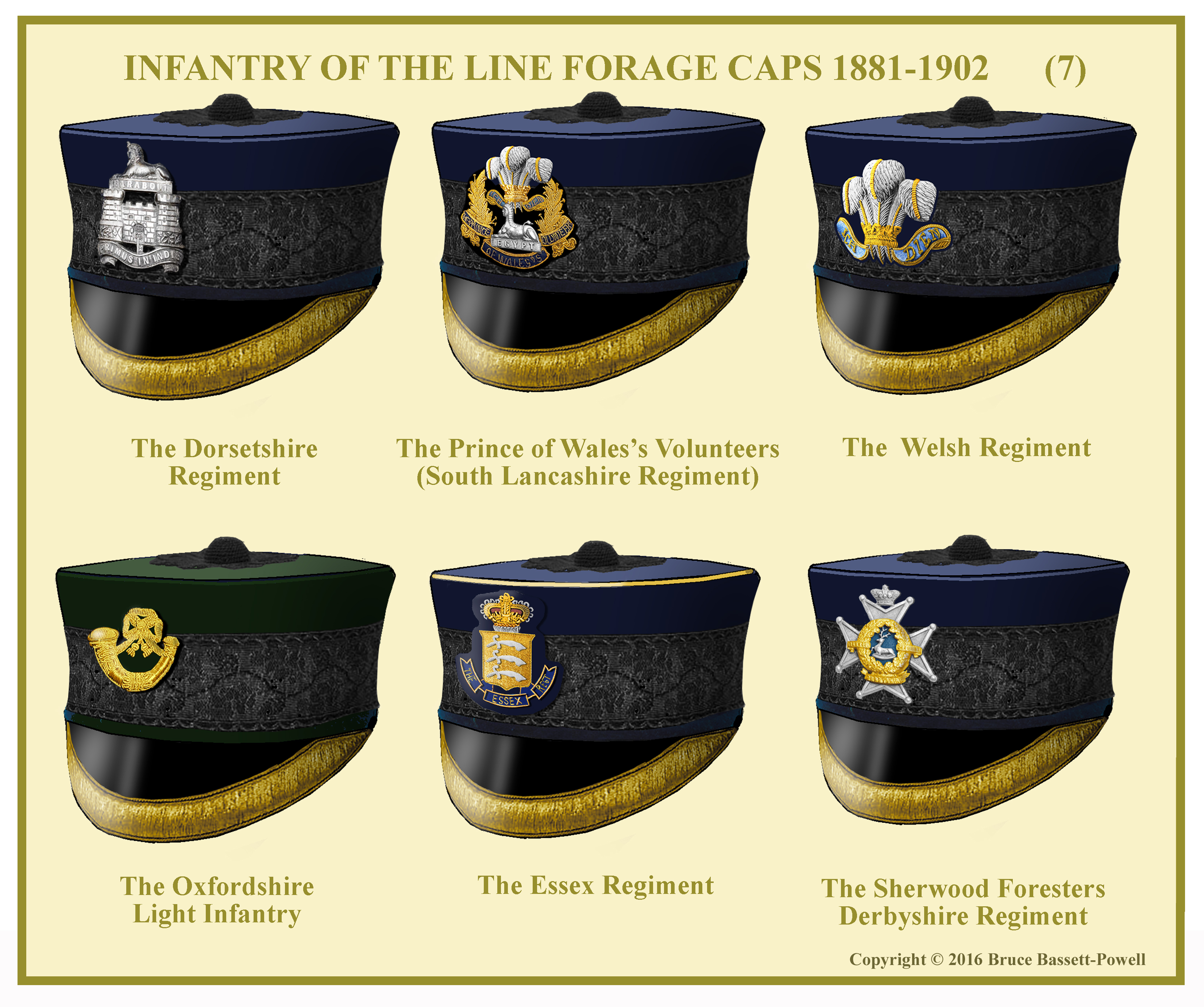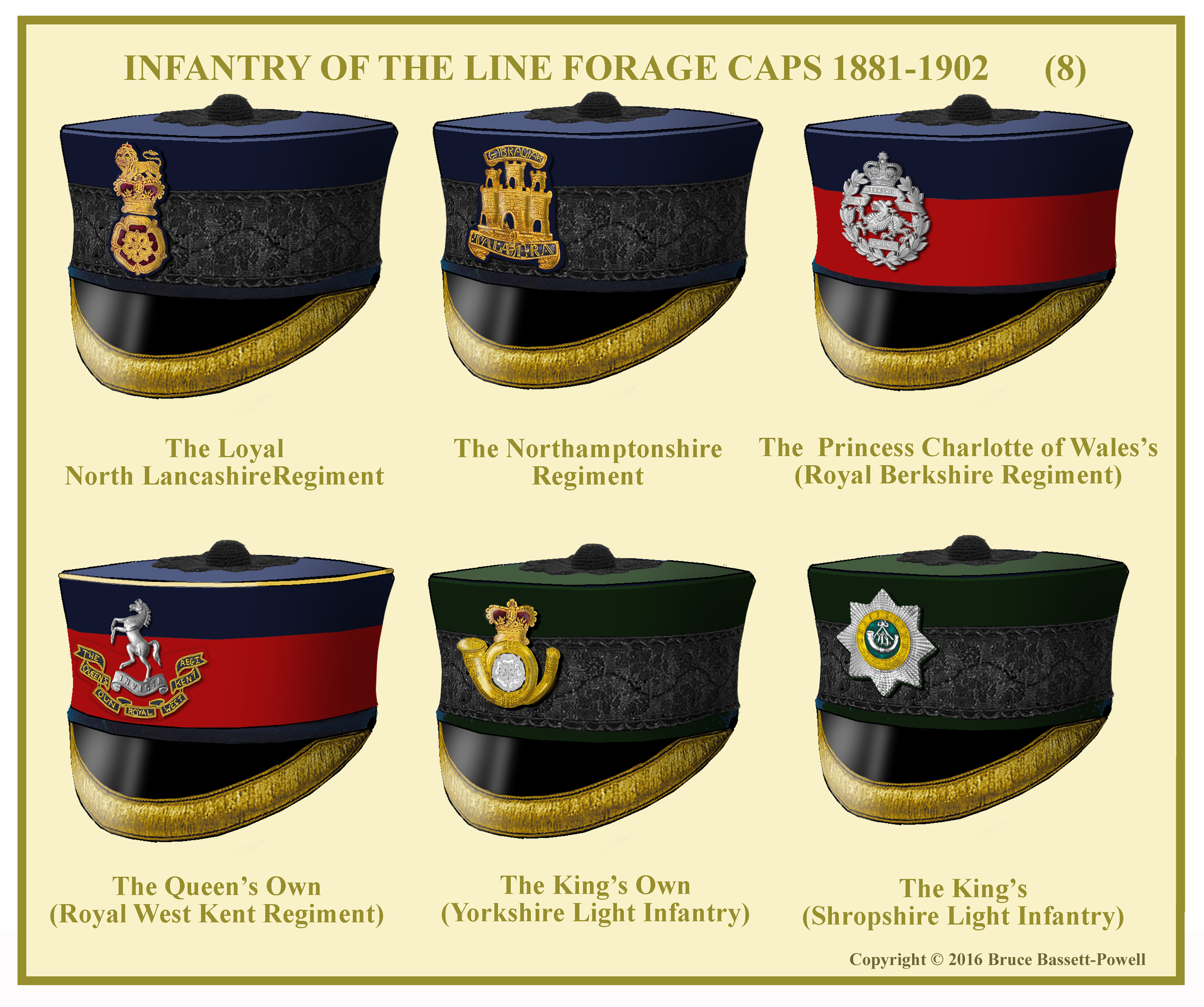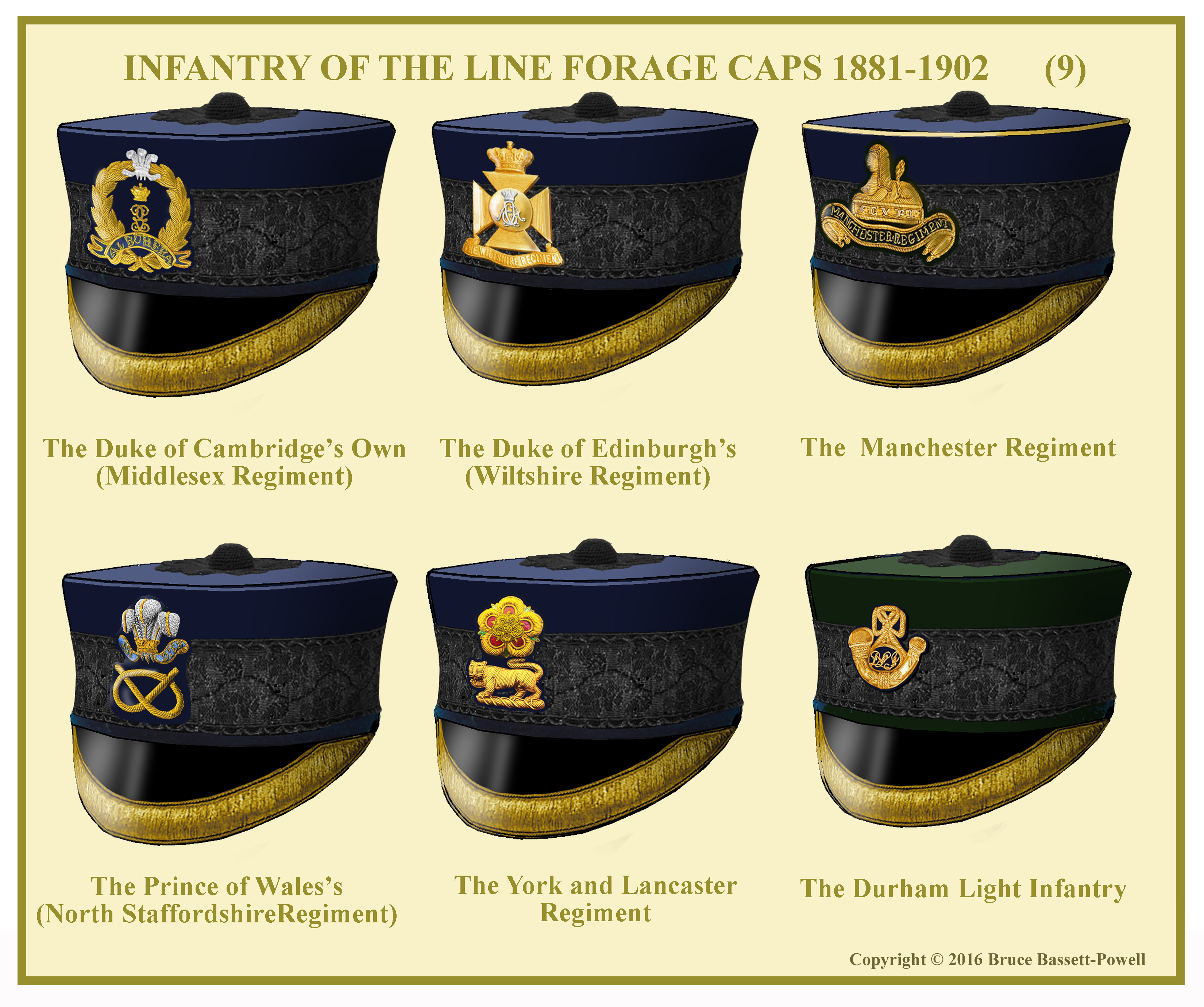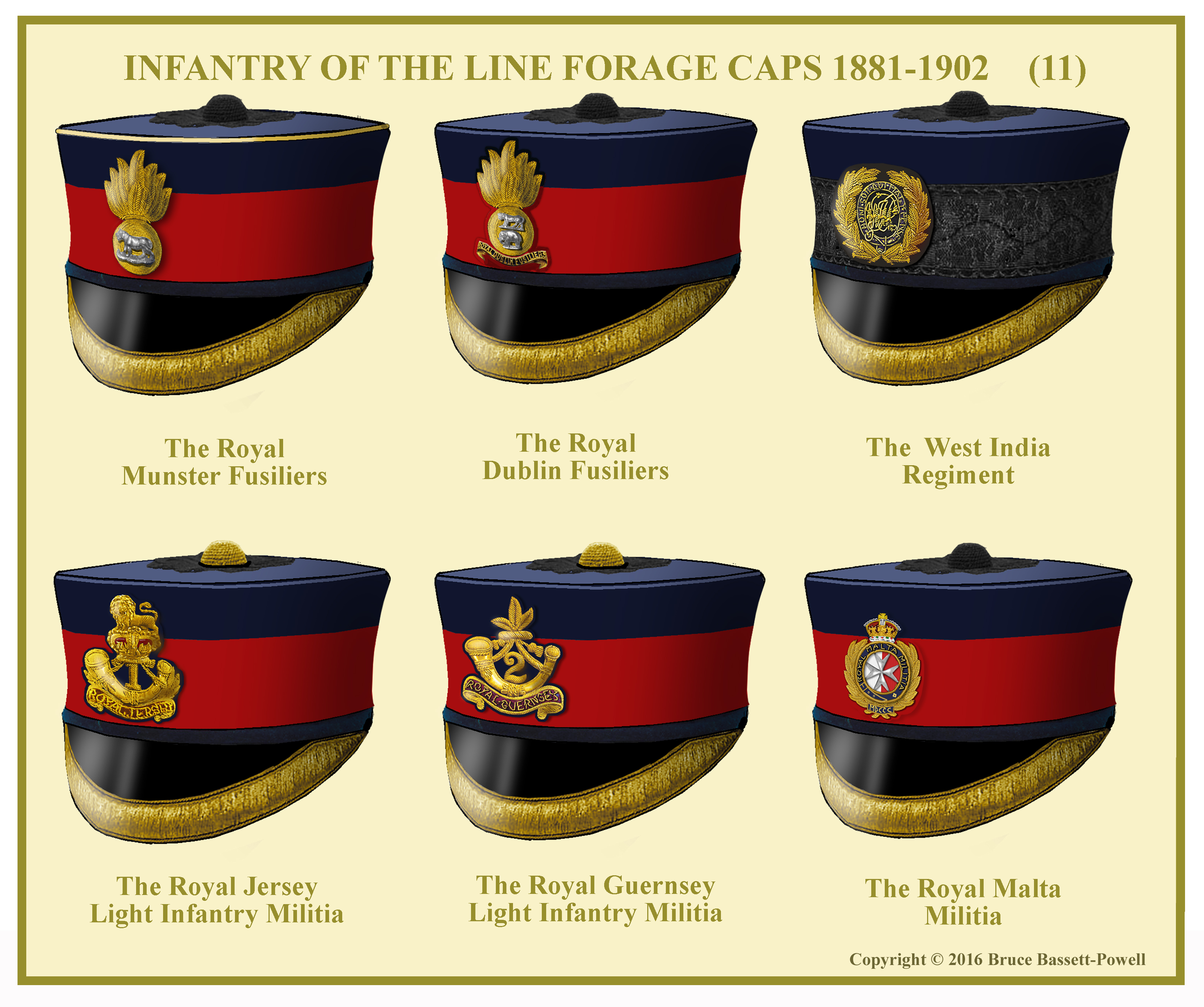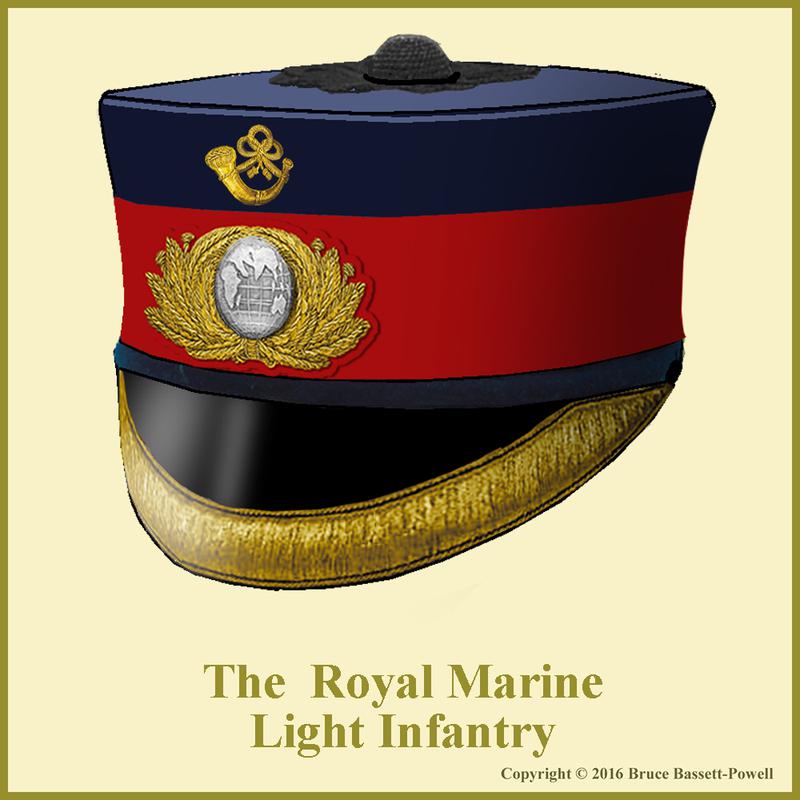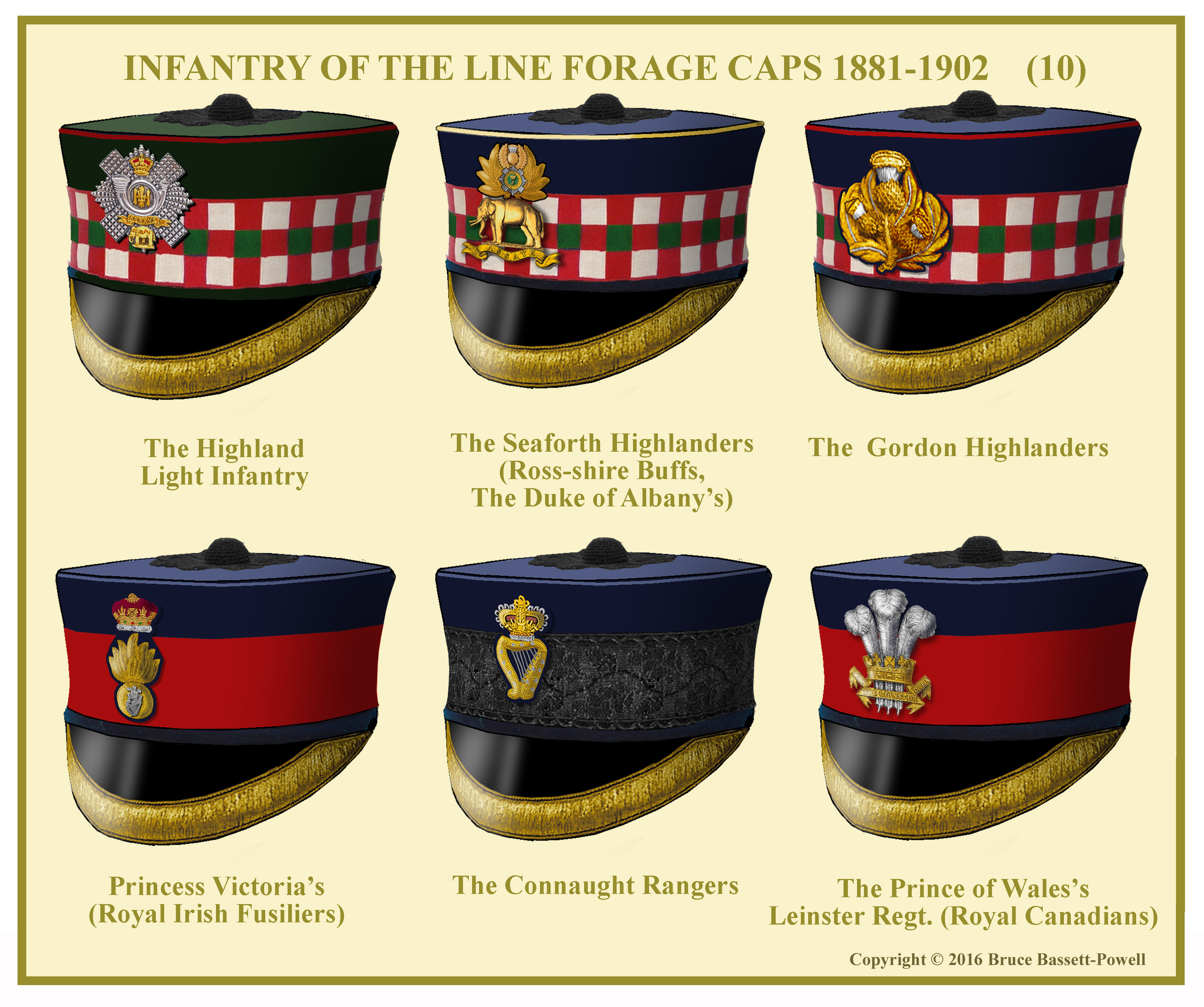PEAKED FORAGE CAPS AND BADGES IN THE BRITISH ARMY 1881-1902
PAGE 2
BADGE DESCRIPTIONS
THE DUKE OF CORNWALL’S LIGHT INFANTRY: In gilt or gilding metal, a bugle with strings. On the strings of the bugle, two red feathers set in gilt or gilding metal. On the stems of the feathers, in silver, a turreted archway. Below, but detached from the badge, a scroll inscribed “The Duke of Cornwall’s Lt. Infy” (This cap was not worn in this regiment after 1897). NOTE: The scroll with inscription appears not to have been worn by all officers & staff sgts. It is possible that the 2nd Battalion did not wear it.
THE DUKE OF WELLINGTON’S (WEST RIDING REGIMENT): In gold embroidery, the Crest of the Duke of Wellington, with motto on a scroll below. The cross in red silk. All on a blue cloth ground.
THE BORDER REGIMENT: In silver, a laurel wreath: on the wreath a Maltese Cross with a lion between each division. On the divisions on the cross, the battles of the regiment. On the centre of the cross, a raised circle inscribed “Arroyo dos Molinos 1811”. Within the circle, on a ground of red and white enamel; the Dragon of China on the red enamel and the word “China” on the white. Below the wreath a scroll inscribed “The Border Regiment”.
NOTE: Before 1890, the badge was described as follows: In gold embroidery on a raised blue cloth ground, a wreath of laurel. Within the wreath, the Dragon of China. See it HERE
THE ROYAL SUSSEX REGIMENT: In silver embroidery, an eight-pointed star on a feather. The stem of the feather in gold embroidery. On the star, the Garter in gilt metal, with the motto pierced; the ground of blue enamel. Within the Garter the Cross of St. George with the ground of red enamel. A blue silk and embroidered scroll inscribed “Royal Sussex Regiment”, the word “Regiment” being in the center of the scroll.
THE ROYAL HAMPSHIRE REGIMENT: In gold embroidery an eight-pointed star. On the star, the Garter in blue silk, surmounted by the Imperial Crown, as represented in the collar of the Order of the Star of India, in gold embroidery. The motto on the Garter in silver. Within the Garter, the Hampshire Rose, in red and gold embroidery.
THE SOUTH STAFFORDSHIRE REGIMENT: On a black cloth ground, the Staffordshire Knot in gold embroidery. Above the knot, the Sphinx over Egypt in gilt or gilding metal.
NOTE: Before 1889, the badge was described as follows: On a raised ground of blue silk, a gold embroidered circle, inscribed “The South Staffordshire Regiment”. The circle surmounted by the Crown in gold embroidery. Within the circle on a black cloth recessed ground, the Sphinx over Egypt with the Staffordshire Knot below, in silver embroidery. The word “Egypt” embroidered in black silk.
The following infantry regiments were not known to have worn the round forage cap between 1883 and 1902.
THE CAMERONIANS (SCOTTISH RIFLES): When the 26th and 90th Regiments were merged in 1881, the round peaked forage cap was worn for a short time. The badge was the silver Mullet in wreath. By the 1883 regulations the regiment was to wear the pill box cap only
THE BLACK WATCH (ROYAL HIGHLANDERS) wearing the blue Glengarry
THE KING’S ROYAL RIFLE CORPS wearing the pill box cap
THE QUEEN’S OWN CAMERON HIGHLANDERS wearing the blue Glengarry
THE ROYAL IRISH RIFLES wearing the pill box cap
PRINCESS LOUISE’S (ARGYLL & SUTHERLAND HIGHLANDERS) wearing the blue Glengarry with red and white diced band.
THE RIFLE BRIGADE (THE PRINCE CONSORTS OWN) wearing the pill box cap
BADGE DESCRIPTIONS
THE LOYAL NORTH LANCASHIRE REGIMENT: In gold embroidery, the Royal Crest; below the Crest, the Rose of Lancaster.
THE NORTHAMPTONSHIRE REGIMENT: In gold embroidery, the Castle and Key. Above the Castle a blue silk, gold embroidered scroll, inscribed “Gibraltar”, and a similar scroll below, inscribed “Talavera”.
THE PRINCESS CHARLOTTE OF WALES’S (ROYAL BERKSHIRE REGIMENT): In silver, chased, within a laurel wreath, the Dragon of China surmounted by a Crown. Beneath the Dragon, the word “China”. Above the Dragon, on a scroll, the words “Royal Berkshire Regiment”.
NOTE: In 1885 the regiment received the title “ROYAL” in honour of their courage at the Battle of Tofrek. They did not change to blue facings and forage cap badge until 1891. Before that the badge was described as; "The Dragon of China in gold embroidery." Photographs show this badge was worn above (the then black oak-leaf pattern) cap band. See it HERE
THE QUEEN’S OWN (ROYAL WEST KENT REGIMENT): In silver, the White Horse of Kent on a scroll inscribed “Invicta”. Below, a blue silk, gold embroidered scroll inscribed “The Queen’s Own Royal West Kent Regt.”
THE KING’S OWN (YORKSHIRE LIGHT INFANTRY): A French horn in gold embroidery surmounted by the Crown; in the centre of the horn, on a raised ground of dark green cloth, the White Rose in silver metal. (This cap was not worn in the regiment after 1897)
NOTE: Prior to 1887, the title of the regiment was; THE KING’S OWN LIGHT INFANTRY (SOUTH YORKSHIRE REGIMENT).
THE KING’S (SHROPSHIRE LIGHT INFANTRY): In gilt metal on a silver eight pointed star, a raised circle inscribed “Shropshire” with two twigs of laurel in the lower bend. Within the circle on a ground of dark green velvet, a bugle with strings, in silver. Within the strings, the monogram in gilt metal. (This cap was not worn in the regiment after 1897)
BADGE DESCRIPTIONS
THE DUKE OF CAMBRIDGE’S OWN (MIDDLESEX REGIMENT): In gold embroidery on a raised blue cloth ground, a laurel wreath; within the wreath, the Prince of Wales’s Plume and motto in silver: Below the Plume in gold embroidery the coronet and cypher of H.R.H. the Duke of Cambridge. On the bottom of the wreath a light blue silk scroll inscribed “Albuhera” in gold embroidery.
THE DUKE OF EDINBURGH’S (WILTSHIRE REGIMENT): The Maltese Cross in lined gilt or gilded metal with burnished edges surmounted by the Coronet in dead gilt metal. On the cross, a round convex, burnished plate. On the plate in silver, the Cypher surmounted by the coronet. A scroll beneath inscribed “The Wiltshire Regiment”.
NOTE: Prior to 1892, the 2nd Battalion wore the badge in gold embroidery with a raised blue cloth convex circle on the cross with Cypher & Coronet in silver. Below, a blue velvet scroll with the regiments name in gold embroidery. See it HERE
THE MANCHESTER REGIMENT: The Sphinx over Egypt in gold embroidery; the word “Egypt” in silver embroidery. Below on a blue cloth gold embroidered scroll, “Manchester Regiment”.
THE PRINCE OF WALES’S (NORTH STAFFORDSHIRE REGIMENT): On a blue cloth ground, the Staffordshire Knot in gold embroidery, surmounted by the Prince of Wales’s Plume in gold and silver embroidery. The motto in silver embroidery on a gold embroidered scroll.
THE YORK AND LANCASTER REGIMENT: On a blue cloth ground in gold embroidery, the Union Rose: Beneath the Rose, the Royal Tiger.
THE DURHAM LIGHT INFANTRY: On a blue cloth ground in gold embroidery, a bugle. Within the strings on a raised blue cloth ground, the letters D.L.I. (This cap was not worn in the regiment after 1897)
BADGE DESCRIPTIONS
THE HIGHLAND LIGHT INFANTRY: In silver, the Star of the Order of the Thistle. On the Star a silver horn; in the centre of the horn. In the centre of the horn, the monogram “H.L.I.” in gilt or gilding metal. Above the horn in gilt or gilding metal, the crown as represented in the collar of Order of the Star of India, the cap of the crown in crimson velvet. Below the horn, a scroll in gilt or gilding metal inscribed “ASSAYE”. Below the scroll, in gilt or gilding metal, the Elephant. (This cap was not worn in the regiment after 1897) NOTE 1: Although Dress Regulations stipulate that the cap of the crown should be of crimson velvet, the authors have determined that this feature was often left off. NOTE 2: A Warrant Officer’s cap in the Scottish United Services Museum is described as being in blue, not dark green. This is not surprising as the full dress shako, described as dark green in 1883, apparently had become dark blue by the late 1890s for both battalions.
SEAFORTH HIGHLANDERS (ROSS-SHIRE BUFFS, THE DUKE OF ALBANY’S): I. In gold embroidery, the Thistle; On the Thistle, the Star of the Order of the Thistle in silver metal. On the Star, a circle in gilt metal; within the circle, on a ground of green enamel, the cypher of the late Duke of York, with coronet above, in gilt metal. II. In dead gilt metal, the Elephant over a scroll inscribed “ASSAYE”. Both badges are worn at the same time, the Elephant below the Thistle. (This cap was not worn in the regiment after 1897)
THE GORDON HIGHLANDERS: The Thistle, in gold and silver embroidery. (This cap was not worn in the regiment after 1897)
PRINCESS VICTORIA’S (ROYAL IRISH FUSILIERS): In gold embroidery, the grenade; above the grenade, the coronet of H.R.H. the Princess Victoria on a silver cushion. In silver, on the ball of the grenade, the Prince of Wales’s feathers over the Harp,
THE CONNAUGHT RANGERS: In gold embroidery on a blue cloth ground, the Harp and Crown; the crown on a crimson velvet cushion.
THE PRINCE OF WALES’S LEINSTER REGIMENT (ROYAL CANADIANS): In silver, the Prince of Wales’s Plume, the scroll with motto and the coronet in gilt or gilding metal. Below the coronet, a scroll in gilt or gilding metal inscribed “The Leinster”.
BADGE DESCRIPTIONS
THE ROYAL MUNSTER FUSILIERS: A grenade in gold embroidery, with the Royal Tiger in silver metal on the ball.
THE ROYAL DUBLIN FUSILIERS: A grenade in gold embroidery; in silver on the ball, the Royal Tiger; below the Tiger, the Elephant. Below and detached from the grenade a scroll in gilt or gilding metal pierced “Royal Dublin Fusiliers". The ground of silver blue enamel.
THE WEST INDIA REGIMENT: In gold embroidery on a blue cloth ground, a wreath of laurel and palm leaves. Within the wreath, the Garter with motto on a blue silk ground. Within the Garter the cypher “WIR”. NOTE: "WIR" in cursive script.
Militia battalions wore the same caps and badges as their counterparts in the regular battalions. There were a few notable exceptions which are not part of this study. The three Militia units below were not battalions of any regular regiments. Their forage cap badges were contained in Dress Regulations and are thus detailed here.
THE ROYAL JERSEY LIGHT INFANTRY MILITIA: In gold embroidery on a blue cloth ground, a bugle with strings surmounted by the Royal Crest. The number of the regiment within the strings of the bugle. A sprig of laurel on each side of the bugle; below, a crimson velvet scroll inscribed “Royal Jersey". The bugle is of special pattern.
THE ROYAL GUERNSEY LIGHT INFANTRY MILITIA: In gold embroidery on a blue cloth ground, a bugle of special pattern surmounted by a sprig of laurel. Within the strings, the number of the regiment. Below, a crimson velvet scroll inscribed “Royal Guernsey”.
THE ROYAL MALTA REGIMENT OF MILITIA: In gold embroidery on a scarlet ground, a wreath. Within the wreath a Garter inscribed “Royal Malta Militia” on a blue silk ground. Within the Garter, a Maltese Cross in burnished silver on a ground in which the left side is in white lined silk and the right side in scarlet lined silk. The Garter is surmounted by the Crown on a blue velvet ground. Below the Garter on a blue velvet ground, a scroll inscribed “MDCCC”.
NOTE: Although Dress Regulations do not specify it, existing badges show an Imperial Crown above the Garter which is shown here.
THE ROYAL MARINES
Another infantry unit wearing the round forage cap, was not under the authority of the Army (or the War Office) but the Admiralty. This was the Royal Marine Light Infantry whose badge was first authorized in the 1874 Royal Navy Dress regulations; Gold embroidered badge with a silver globe in the centre, gold embroidered bugle at top. (Note the more business like description used by the Admiralty). The cap was described as Blue cloth, with peak. 1 ¾ Inch band of oak leaf lace. This was changed in 1880 to a scarlet band but the badge description remained the same.
The Royal Marine Artillery wore the pill box cap like their counterparts in the army.
Round forage caps worn by Headquarters Staff, Corps, Departments and Instruction Corps.
BADGE DESCRIPTIONS
THE DORSETSHIRE REGIMENT: The Castle and Key. Above the castle, the Sphinx resting on a tablet inscribed “Marabout”. Below the Castle, a scroll, with the words “Primus in Indis”. The whole in silver.
NOTE: Before 1895 the badge was described as follows; The Castle and key; the Castle in silver, the Key in gilt metal. Above the castle a scroll in gilt metal, with the words “Primus in Indis” in gilt metal on a ground of green enamel. Below the castle a gilt scroll with the words “Montis Insignia Calpe” in gilt letters on a ground of green enamel. Under this scroll the Sphinx in gilt metal resting on a gilt tablet inscribed “Marabout” on a ground of green enamel. See it HERE
THE PRINCE OF WALES’S VOLUNTEERS (SOUTH LANCASHIRE REGIMENT): In silver on a raised ground of blue cloth, the Sphinx over Egypt. Above the Sphinx in gold and silver embroidery, the Prince of Wales’s plume, the motto in silver embroidery on a blue silk ground. On each side a laurel branch in gold embroidery. A blue silk, gold embroidered scroll inscribed “The Prince of Wales’s Volunteers”.
THE WELSH REGIMENT: In gold and silver embroidery, on a blue cloth ground, the Prince of Wales’s Plume; the scroll in blue silk, the motto in silver embroidery.
NOTE: Until 1902 the description adds the words “1st Bn in metal”. Whether this means silver or gilt metal is not mentioned. Photographs of the 1st Bn staff in caps seem to show silver and the badge is somewhat smaller than the embroidered version.
THE OXFORDSHIRE LIGHT INFANTRY: A bugle with strings in gold embroidery on a green cloth ground. (This cap was not worn by the regiment after 1897)
THE ESSEX REGIMENT: On a raised ground of blue cloth, a blue silk gold embroidered scroll inscribed “The Essex Regt”. Within the scroll, the county badge surmounted by the Crown. The Crown and Shield in gold embroidery and the Seaxes in silver embroidery.
THE SHERWOOD FORESTERS (DERBYSHIRE REGIMENT): A Maltese Cross surmounted by the Crown, in silver. In the centre of the cross an oak leaf wreath in gilt or gilding metal. On the wreath in gilt, a half scroll on the left division of the cross inscribed “Sherwood”. On the right division a half scroll inscribed “Foresters” On the lower division a scroll inscribed “Derbyshire” Within the wreath a stag, lodged, in silver on a ground of silver blue enamel.


